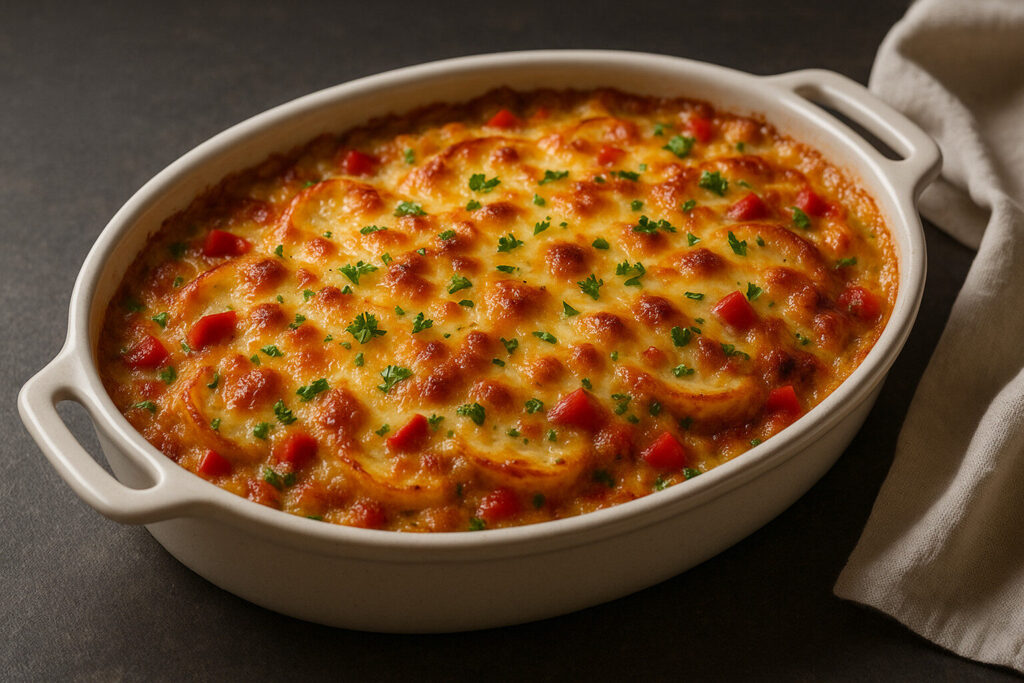
A casserole is a baked dish that combines ingredients in layers or as a mix, cooked slowly in the oven until flavors blend. Unlike a gratin, which focuses on a crust, a casserole is defined by its hearty, all-in-one character. Pasta, rice, vegetables, meat, or fish are bound together with sauces and often finished with cheese. The role of cheese in a casserole is broader than in most other dishes: it works inside as a binder, on top as a crust, and sometimes even both.
Cheese is what transforms a casserole from a collection of ingredients into a cohesive meal. It adds creaminess, holds food together, and provides a final golden surface. The choice of cheese determines whether the dish becomes rich and heavy or balanced and refined.
Comparative Cheese Table (Main Roles)
| Cheese Type | Role in Casserole | Flavor Profile | Best Pairings | Cost (approx.) |
|---|---|---|---|---|
| Mozzarella | Binder, topping | Mild, creamy | Pasta, vegetable casseroles | Low–medium |
| Provolone | Binder, smooth melt | Mild, slightly sharp | Rice, pasta casseroles | Medium |
| Cheddar | Topping, sharp | Tangy, strong | Meat, vegetable casseroles | Medium |
| Gruyère | Topping, binder | Nutty, earthy | Meat, potato casseroles | High |
| Fontina | Binder, creamy | Nutty, smooth | Mushroom, pasta, rice | Medium–high |
This table shows how differently cheeses can behave depending on their structure and taste. Some act best as binders, melting into the bulk of the dish, while others shine as toppings that brown and crisp.
How Cheese Works in Casseroles
Inside a casserole, cheese acts as a glue. Melted mozzarella or provolone, layered between pasta or vegetables, keeps the structure together and prevents the dish from falling apart when sliced. In sauces, soft cheeses such as ricotta or mascarpone make the texture creamy, while sharper hard cheeses like Parmesan or Pecorino Romano contribute salt and umami without adding bulk.
On top of a casserole, cheese works differently. Cheddar, Gruyère, or aged Gouda melt and brown, creating a crust that contrasts with the soft interior. This contrast between creamy inside and crispy outside is one of the signatures of a good casserole.
Matching Cheese to Casserole Types
Each type of casserole benefits from different cheeses. Pasta casseroles need stretch, so mozzarella combined with Parmesan works well. Rice casseroles absorb nutty cheeses such as fontina or provolone, which distribute flavor evenly. Vegetable casseroles thrive with sharper cheeses like cheddar or blue cheese, which bring contrast. Meat casseroles, rich in fat and flavor, stand up to Gruyère, smoked scamorza, or aged Gouda. Seafood casseroles are more delicate and should use mild cheeses like mascarpone, ricotta, or mozzarella to avoid overpowering the fish.
Intense and Neutral Cheeses
Neutral cheeses such as mozzarella, provolone, or Monterey Jack form the backbone of most casseroles. They melt predictably, give smoothness, and let other ingredients speak. Intense cheeses — aged cheddar, Gruyère, taleggio, or blue cheese — need restraint. In small amounts, they create complexity and make a dish memorable, but in excess they dominate. The most balanced casseroles often use one neutral cheese for creaminess and one intense cheese for flavor depth.
Exquisite Casserole Cheeses
Some cheeses transform a casserole into a gourmet dish. Taleggio introduces earthy richness, especially in mushroom-based casseroles. Smoked scamorza or smoked Gouda give rustic, fire-like flavor. Burrata, if added just before serving, melts into a creamy top layer that contrasts beautifully with baked vegetables. Fontina, with its nutty smoothness, is one of the best options for layered pasta casseroles. Even a few flakes of Parmesan after baking can refine a casserole with salty sharpness.
Price and Nutrition Comparison (per 100 g, average values)
| Cheese Type | Avg. Price €/kg | kcal | Protein (g) | Fat (g) | Salt (g) |
|---|---|---|---|---|---|
| Mozzarella | 8–12 | 280 | 18 | 20 | 0.9 |
| Provolone | 12–15 | 350 | 26 | 27 | 1.8 |
| Cheddar | 10–14 | 400 | 25 | 33 | 1.8 |
| Gruyère | 20–26 | 413 | 30 | 32 | 1.6 |
| Parmesan | 18–24 | 430 | 38 | 29 | 1.6 |
| Fontina | 15–18 | 390 | 26 | 31 | 1.5 |
| Taleggio | 18–22 | 360 | 20 | 29 | 2.0 |
| Smoked Scamorza | 12–16 | 330 | 22 | 26 | 2.2 |
| Blue Cheese | 16–20 | 350 | 21 | 29 | 3.0 |
| Ricotta | 8–12 | 170 | 11 | 13 | 0.2 |
(Values are approximate averages. Prices and nutrition vary by region and producer.)
Conclusion
Casseroles are comfort food by definition, and cheese is their backbone. Neutral cheeses provide body, intense ones create accents, and exquisite varieties turn everyday dishes into something special. From mozzarella and Parmesan in pasta casseroles to Gruyère in potato layers or taleggio in mushrooms, the right cheese makes the difference between heavy and harmonious. By mixing textures and flavors wisely, a casserole becomes not only filling but also balanced and memorable.
